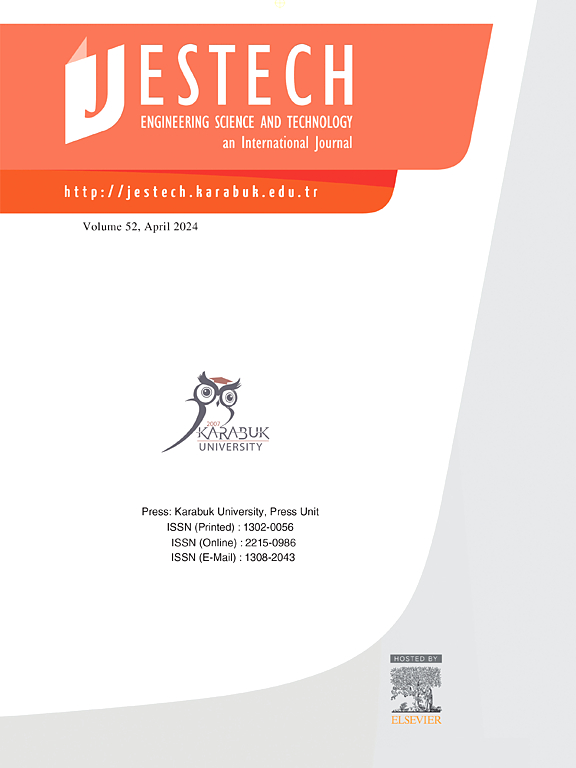Transformer differential protection with wavelet transform and difference function
IF 5.4
2区 工程技术
Q1 ENGINEERING, MULTIDISCIPLINARY
Engineering Science and Technology-An International Journal-Jestech
Pub Date : 2025-07-27
DOI:10.1016/j.jestch.2025.102144
引用次数: 0
Abstract
The Transformer Differential Protection (TDP) algorithm instantly compares the target transformer’s terminal currents for each phase. The differential current is not expected to appear during regular operation. However, nonlinear characteristics of the core material, such as the hysteresis curve, result in significant variation in the differential current, known as magnetizing inrush current. This inrush current lasts for a while before disappearing, causing significant variation in the differential current. TDP algorithm is supposed to remain silent during this transient time (selectivity). In addition, one of the most difficult tasks for protection systems is detecting inter-turn faults in their early stages. This fault type typically begins at low levels due to moisture, high temperature, and so on, and gradually spreads to other turns. It is vital to detect inter-turn faults before they expand more than 10% of total windings [RW-2-1]. This paper presents a transformer differential protection algorithm that distinguishes between inter-turn, low-level internal faults, and inrush current. Maximum Overlapped Discrete Wavelet Transform (MODWT) energy and difference function are used for feature extraction, and the traditional 87T TDP method has been updated. Performance is evaluated using data collected from a laboratory-based experimental rig. The results demonstrate that the suggested approach performs very well in a range of low-level, inter-turn fault, and transient scenarios, including internal fault, inrush current, and sympathetic inrush current. These results are confirmed by the identified indices for Accuracy (AC), Dependability (DP), and Selectivity (SE).
采用小波变换和差分功能的变压器差动保护
变压器差动保护(TDP)算法可即时比较目标变压器各相的终端电流。在正常运行期间,不希望出现差动电流。然而,磁芯材料的非线性特性,如磁滞曲线,会导致差动电流(即磁化涌流)的显著变化。这种涌流在消失之前持续一段时间,导致差分电流的显著变化。TDP算法应该在这个短暂的时间内保持沉默(选择性)。此外,保护系统最困难的任务之一是在早期阶段检测匝间故障。这种故障类型通常由于潮湿、高温等原因从低电平开始,并逐渐扩散到其他匝数。在匝间故障扩展到总绕组的10%以上之前进行检测是至关重要的[RW-2-1]。提出了一种变压器差动保护算法,该算法能够区分匝间故障、低电平内部故障和涌流。利用最大重叠离散小波变换(MODWT)能量和差分函数进行特征提取,对传统的87T TDP方法进行了更新。使用从基于实验室的实验装置收集的数据来评估性能。结果表明,所提出的方法在低电平、匝间故障和瞬态场景(包括内部故障、涌流和共感涌流)中表现良好。这些结果通过确定的准确性(AC),可靠性(DP)和选择性(SE)指标得到证实。
本文章由计算机程序翻译,如有差异,请以英文原文为准。
求助全文
约1分钟内获得全文
求助全文
来源期刊

Engineering Science and Technology-An International Journal-Jestech
Materials Science-Electronic, Optical and Magnetic Materials
CiteScore
11.20
自引率
3.50%
发文量
153
审稿时长
22 days
期刊介绍:
Engineering Science and Technology, an International Journal (JESTECH) (formerly Technology), a peer-reviewed quarterly engineering journal, publishes both theoretical and experimental high quality papers of permanent interest, not previously published in journals, in the field of engineering and applied science which aims to promote the theory and practice of technology and engineering. In addition to peer-reviewed original research papers, the Editorial Board welcomes original research reports, state-of-the-art reviews and communications in the broadly defined field of engineering science and technology.
The scope of JESTECH includes a wide spectrum of subjects including:
-Electrical/Electronics and Computer Engineering (Biomedical Engineering and Instrumentation; Coding, Cryptography, and Information Protection; Communications, Networks, Mobile Computing and Distributed Systems; Compilers and Operating Systems; Computer Architecture, Parallel Processing, and Dependability; Computer Vision and Robotics; Control Theory; Electromagnetic Waves, Microwave Techniques and Antennas; Embedded Systems; Integrated Circuits, VLSI Design, Testing, and CAD; Microelectromechanical Systems; Microelectronics, and Electronic Devices and Circuits; Power, Energy and Energy Conversion Systems; Signal, Image, and Speech Processing)
-Mechanical and Civil Engineering (Automotive Technologies; Biomechanics; Construction Materials; Design and Manufacturing; Dynamics and Control; Energy Generation, Utilization, Conversion, and Storage; Fluid Mechanics and Hydraulics; Heat and Mass Transfer; Micro-Nano Sciences; Renewable and Sustainable Energy Technologies; Robotics and Mechatronics; Solid Mechanics and Structure; Thermal Sciences)
-Metallurgical and Materials Engineering (Advanced Materials Science; Biomaterials; Ceramic and Inorgnanic Materials; Electronic-Magnetic Materials; Energy and Environment; Materials Characterizastion; Metallurgy; Polymers and Nanocomposites)
 求助内容:
求助内容: 应助结果提醒方式:
应助结果提醒方式:


